Author(s): Felipe Sebastián Garrido De La Guarda
There is currently a context of climate change due to the way modern cities are developed, and they are made up mainly of impermeable surfaces and concrete buildings that change the hydrological cycle, causing (i) An increase in temperatures, (ii) The accumulation of stormwater on different surfaces, (iii) Overflow in drainage systems, and (iv) The alteration of ventilation patterns, among others. This article presents a case study on the implementation of a permeable interlocking concrete paving (PICP) system, and it develops physical–mathematical modeling using software for the design of a parking lot that currently does not have adequate paving and urban drainage, resulting in sporadic flooding due to heavy rainfall in the city of Temuco, La Araucanía region, Chile. This article’s contribution highlights the application of new technology in Chile, discussing road infrastructure solutions based on Sustainable Urban Drainage Systems (SUDSs), which seek to implement feasible alternatives in urban sectors to improve human livelihood. The factors studied include structural and hydrological properties, along with the infiltration analysis of the system according to historical rainfall records in the area. This research concludes that the permeable pavement system with a drainage pipe and smooth roughness coefficient performs satisfactorily for an extreme hydrometeorological event corresponding to 140 mm considering 24 h of rainfall with a return period of 100 years equivalent to an inflow of 673 m3 /day. Finally, the results indicate that, at least in the conditions of the city of Temuco, the use of permeable interlocking concrete pavement (PICP) proves to be a sustainable and feasible alternative to implementing measures of adaptation and mitigation against climate change, reducing the city’s flooding zones and allowing the irrigation of urban green areas.
Both in Chile and many countries around the world, there is increasing urban growth, where the urbanization of natural basins causes an alteration of their corresponding hydrological processes [1-3]. These basins, which are subject to constant urbanization, present more rapid flooding, making the consequences of flooding increasingly severe; presenting a lack of sustainable urban rainwater management systems in which extreme hydrometeorological events test the performance of urban drainage systems; and causing countries to demand new solutions to adapt to climate change [4-6].
According to data from the 2017 population census, Chile is one of the most urbanized countries in Latin America, with 87.8% of the population urbanized; it continues to grow compared to previous censuses as it reached 83.5% in 1992 and 86.6% in 2002. According to the above, the progressive decrease in the rural population stands out both in terms of percentage and absolute terms. These antecedents provide a signal of the changes in land use and the associated modification of the infiltration and runoff conditions of rainwater [7-10].
This research is developed with the objective of providing a pavement infrastructure solution for the adaptation and mitigation of climate change, considering the current lack of sustainable urban drainage infrastructure systems that can manage runoff caused by extreme precipitation events [11-13]. The exceedance of stormwater management capacity in cities due to the growth and waterproofing of soils causes urban flooding, directly affecting users within residential, commercial, and industrial areas [14,15]. Furthermore, cities currently lack a variety of stormwater drainage uses, such as irrigating a city’s green areas, thus allowing these ecosystems to capture more CO2 and providing landscape benefits that improve the quality of human life thanks to the process of photosynthesis [16-19].
Permeable interlocking concrete pavement (PICP) consists of manufactured impermeable concrete units (pavers) that form permeable voids and joints when assembled in a placement pattern [20-22]. The openings normally comprise between 5% and 15% of the paver surface, which maintains high permeability with small-sized aggregates [23,24]. According to several authors, the cross-section of the PICP structure is detailed in Figure 1 [25-27].
The openings allow stormwater to enter a layer of permeable bedrock and a base/subbase that supports the pavers while providing runoff storage and treatment. PICP replaces traditional impervious pavement in most pedestrian and vehicular applications, except high-volume/high-speed roads [28,29]. This has been used successfully on pedestrian crossings, sidewalks, driveways, parking lots, and low-traffic roads [25].
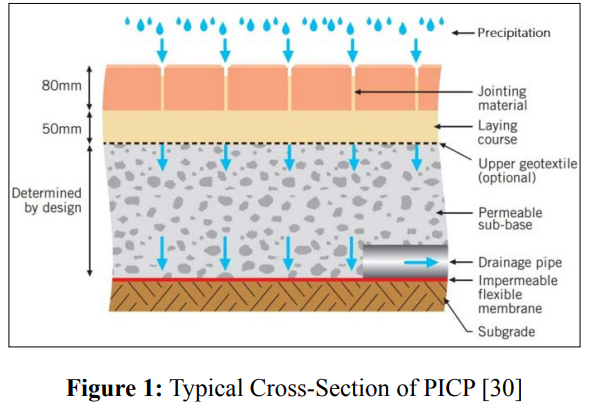
Urban development in Chile results in significant changes in land use and functional connections between urban and rural areas [31]. Currently, in Chile, there is a significant deficit in advances in stormwater management, resulting in flooding within urban areas due to the waterproofing of soils [32]. Changing the relationship between the use of urban and rural areas leads to changes in residents’ quality of life, the environment, and ecosystem services, including water resources [33].
The issue of water resources management is critical in the context of increasing urbanization, observed and projected climate change, and extreme events, such as floods and droughts, which have been particularly severe in Chile in recent decades [31].
The research gap addressed by this study highlights the application of new technology in Chile, discussing road infrastructure solutions based on sustainable urban drainage systems (SUDSs), which seek to implement feasible alternatives in urban sectors to improve human livelihood and contribute to the adaptation and mitigation of climate change.
Based on the above information, this research seeks to respond to the following objectives throughout the course of the study, with these being relevant for its development and formulation
The research is descriptive, explanatory, and non-experimental, utilizing a quantitative approach. According to the information obtained, analyses were carried out to predict the behavior that the permeable paving system will have in the area where it is desired to be implemented, and at the same time, an evaluation of the impact that its use entails in the study areas was carried out, along with the effect that it will generate on citizens.
In this research, modeling and simulation were carried out using specialized software. Typical soil properties of the study area and representative climatic parameters based on historical statistical records were considered. The Pueblo Nuevo meteorological station (Temuco, Chile) was considered in this study, with a hydrological time series from 1953 to 2020 to obtain the maximum annual 24 h rainfall [34].
For the reasons presented above, physical-mathematical modeling was developed using specialized software to verify the structural and hydrological feasibility of Sustainable Urban Drainage Systems (SUDSs). Permeable Interlocking Concrete Pavement (PICP) design software called “Permeable Design Pro” was used [35]. Permeable Design Pro Software version 2.1.0.0, corresponding to the year 2020, is a non-open-source software developed by Applied Research Associates Inc. and Interlocking Concrete Pavement Institute (ICPI). Similarly, digital meteorological databases were used, such as rainfall information provided by the Pueblo Nuevo station belonging to the General Directorate of Water. In the same way, a review of the literature related to the permeable interlocking concrete paving system was carried out based on scientific journals (reviews and articles) and research from undergraduate thesis projects at different universities, both national and international.
As for the research that refers to the regulatory framework, this was carried out based on associations, societies, and engineering institutions that specialized in the established area. Technical information on the design and serviceability of pavement structures was specifically investigated within the Guide for the Design of Pavement Structures, according to the American Association of State Highway and Transportation Officials (AASHTOs) [36,37]. Finally, the standards and methodologies implemented by both the American Society for Testing and Materials (ASTMs) and the Interlocking Concrete Pavement Institute (ICPI) were considered [35].
When designing a permeable pavement, two relevant aspects must be taken into consideration: one of them refers to the structural behavior, that is, the support capacity of the pavement, and the other refers to the hydraulic-hydrological behavior, that is, the ability to drain and store predicted rainfall [38].
The software uses the Interlocking Concrete Pavement Institute (ICPI) design criteria [35], which reflect the most advanced practices based on experience in North America and abroad. Standard hydrologic and structural design procedures are integrated into a comprehensive method to estimate the pavement capacity necessary to support the traffic load and drain, store, and infiltrate surface water runoff. The software allows you to run a sensitivity analysis of the key variables to find the optimal design for the development of a project on a given site [35].
Permeable Design Pro Software was used to evaluate the viability of using the permeable interlocking concrete paving system proposed in this study.
The study area location is in the parking lot called “Pablo Neruda Avenue 1100 Parking”, with a size of 5643 m2, within the Germán Becker Stadium Park area, city of Temuco, La Araucanía region, Chile, with the following coordinates: latitude 38°44’28.7” S and longitude 72°37’13.5” W (Datum WGS 84), and an approximate elevation of 110 masl. The temperature ranges between -5.6 °C and 39.8 °C. Precipitation varies between 780.8 and 1421.5 mm annually, with two different seasons: the rainy season (April- October) and the dry season (November-March).
The study area includes the road infrastructure of the Parque Estadio Germán Becker sector, located on Pablo Neruda Avenue within the City of Temuco, Chile. Specifically, the sample selection is defined within the area that covers the parking in the sector. Figure 2 shows the public space according to the present records, highlighting the pavement surface’s deterioration due to the accumulation of stormwater during intense rainfall events in the area, thus resulting in flooding and challenges for both adequate pedestrian and vehicle traffic.
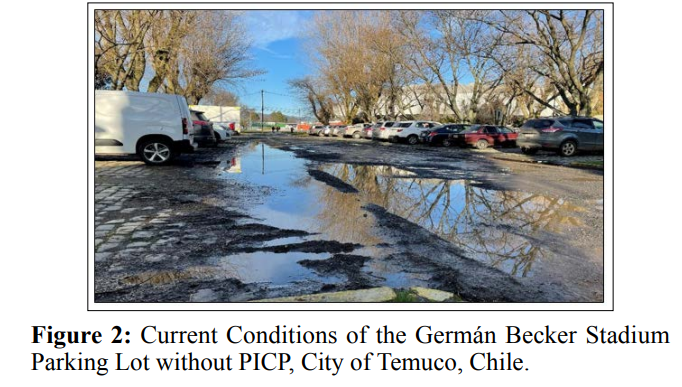
The study area was selected because it is a critical place for rainwater drainage where waterlogging and flooding usually occur, which is a representative point of runoff discharge from the German Becker stadium sector.
A pavement system’s water amount is described as a water balance. This volume in the paving system is calculated according to Equation (1).

where the Volume of Water is represented in m3 and Time is represented in h.
The water that enters the pavement comes from precipitation or contributing areas, due to which it can accumulate on the surface of the paving system and the contributing areas. Subsequently, water that falls onto the pavement can infiltrate the structure’s granular material or run off the pavement’s surface [35]. If runoff occurs within the system, it can be estimated based on Equation (2).

where Q is the direct runoff represented in mm, P is the Precipitation represented in mm and CN is the curve number according to the SCS method.
Water infiltration is calculated in a series of regular time steps, where precipitation is converted to water input volume during each interval. Due to the additional distance that water must travel from the catchment areas to the pavement, an additional time lag is expected to affect the water inflow distribution [35]. The expected delay is calculated according to Equation (3).

where Tt is the travel time represented in hours, n is the Manning roughness number, L is the path length represented in m, P is the precipitation in 24 h represented in mm, and S is the longitudinal slope represented in %.
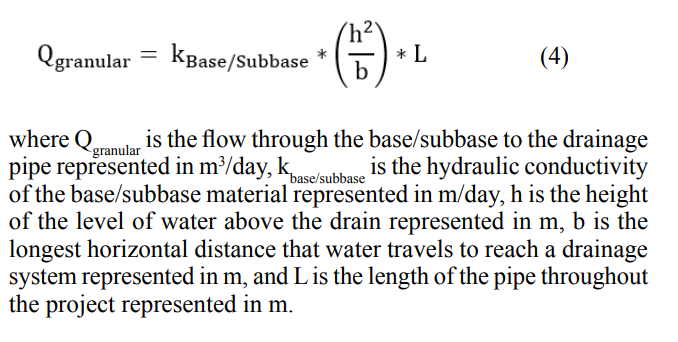
According to [35], if the base material can drain quickly, more water may try to pass through the drainpipes than gravity allows. This could be the limiting factor if some porous materials’ pipes are poorly designed. Manning’s equation (Equation (5)) estimates the amount of water flow in a pipe.

where Q pipe is the maximum flow of water through any pipe represented in m3/day, n is the Manning roughness coefficient, r is the radius of the pipe represented in m, and s is the longitudinal slope of the pipe represented in %.
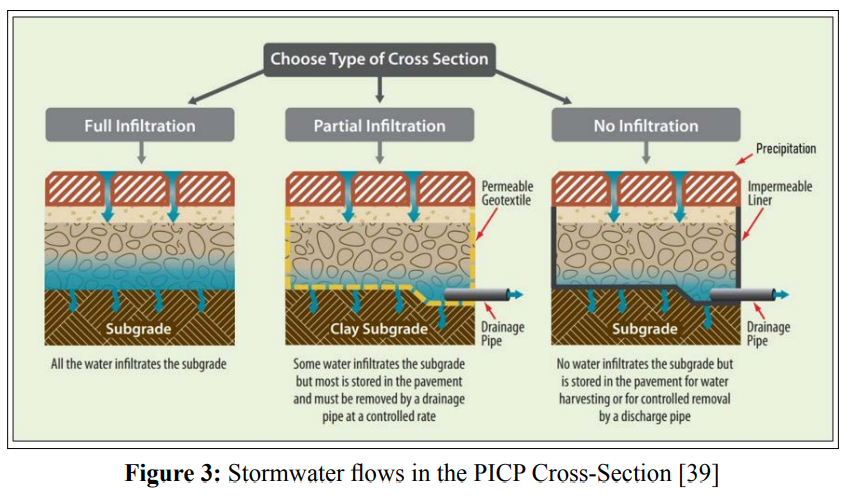
In accordance with the response to the first specific objective (i), the considered structural parameters of the design layers such as thickness, porosity, void ratio, permeability, and resistance in the case of the subgrade, as indicated in Table 1, represent specifications, results, and influencing factors, with the purpose of understanding the behavior of permeable interlocking concrete paving layers.
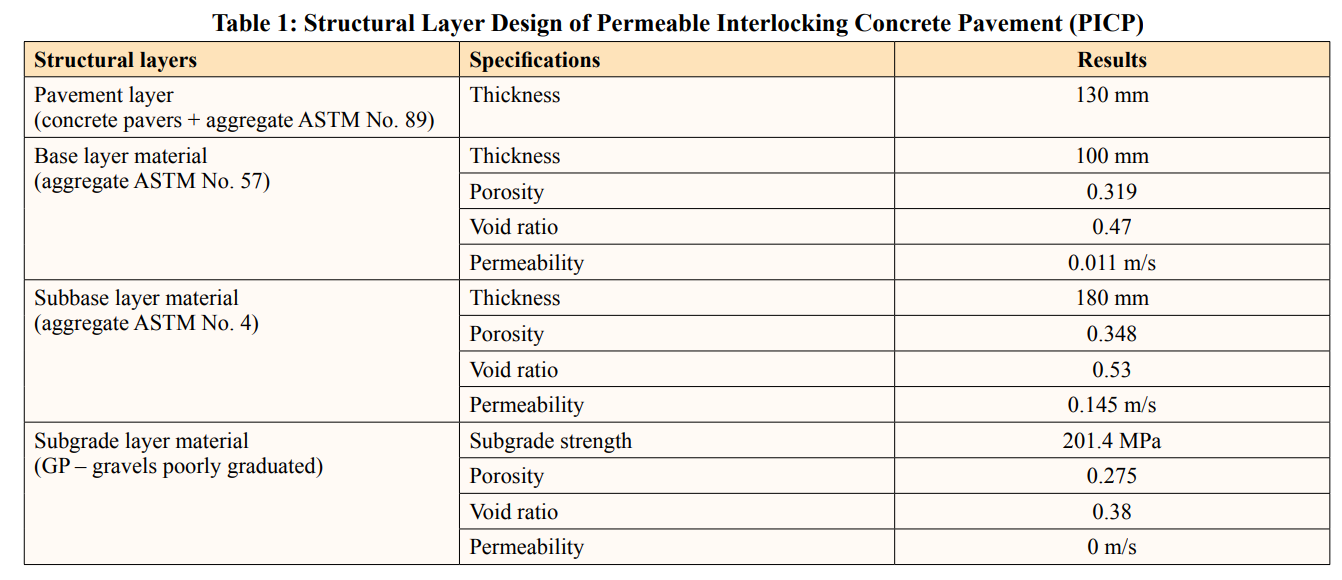
Based on the determined design, the maximum water depth allowed in the base/subbase material is 85% of the thickness. Meanwhile, an assumption is made that there is no presence of water in the subbase material.
Below, according to [35], a representative scheme (Figure 4) of a permeable paving system is shown, which specifies the complete structure of a permeable interlocking concrete pavement without infiltration into the subgrade layer in relation to the information obtained in Table 1.
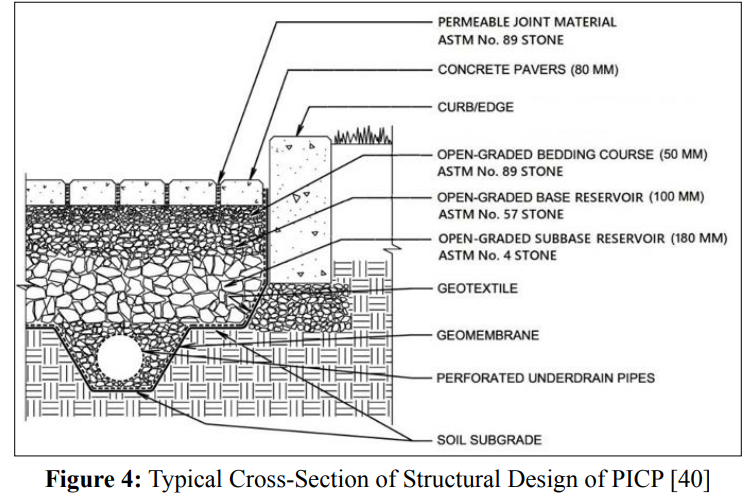
Within the design considerations, a case study was carried out, where the subbase layer had a thickness of 180 mm, demonstrating an optimal response capacity in the system with smooth drainage pipes. In Table 2, the water balance results are presented for a system with drainage pipes with a smooth roughness coefficient, with the purpose of demonstrating the performance of the permeable interlocking concrete paving system through physical-mathematical modeling, thus addressing the constructive development that its implementation entails.

Table 2 shows the system’s response to the entry and exit of water flows, with the time represented in hours according to the storm return periods. According to these data, a visual representation is made, which describes the behavior of the attached data, as shown in Figure 5.
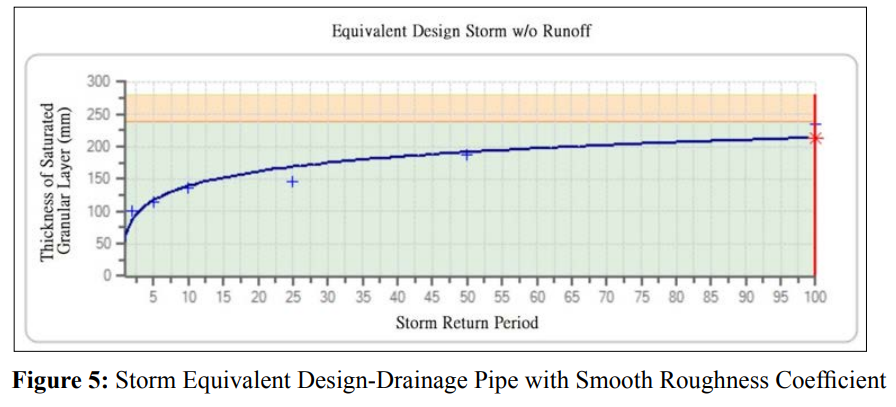
The recorded data represent the 2, 5, 10, 25, 50, and 100-year return periods entered into the software. If these points are within 85% of the maximum allowable depth of water in the granular layer, it translates into optimal storage capacity during storm periods. It is seen that these values form a trend line that represents the saturation behavior for the thickness of the granular layer of the system.
Responding to the second specific objective (ii), for the return periods studied, the system could not produce saturation, complying with the results of water balances versus precipitation intensities, according to the analysis provided using the software. The above is corroborated according to Figure 5, projecting in the graph that this design effectively supports a return period of up to 100 years. Therefore, the percentage of the maximum storage capacity that one proposes for the design will be directly influenced by precipitation events depending on the project’s location. Given the above, if the proposed percentage is exceeded, the area’s storage capacity against rainwater events will be compromised.
According to the previous results, in Table 3, information is presented for verification purposes to both elucidate if the project satisfies the proposed conditions according to the proposed design and present results that evaluate the feasibility of using the permeable interlocking concrete pavement in the city of Temuco, considering the historical records of precipitation.

In response to the third objective (iii), the system modeled in the software satisfies the hydrological evaluation criteria in terms of the established infiltration and storage capacity. According to the above, the feasibility of a design suitable for the hydrological conditions in Temuco, Chile, is confirmed.
To drain, store, and reuse this water in a groundwater reservoir system, a procedure was designed based on zero infiltration into the subgrade layer. To achieve the above, three 100 mm diameter drainage pipes were implemented, with a distance to the bottom of the base of 75 mm and a smooth roughness coefficient, meeting the output capacity of the accumulated water within the system without causing surface runoff.
With a 130 mm pavement and transition layer, a 100 mm base, and a 180 mm subbase, the paving model is capable of withstanding a 100-year design storm return period, according to the conditions above, as shown in Table 3.
According to this return period, the accumulated volume was 673 m3 for the surface inflow. In the case of outlet drainage, the water storage collected in the pavement is 237.8 m3, so the pipes would drain a total of 435.2 m3 during a storm, as shown in Table 2.
Consequently, the total storage capacity of the permeable pavement was never exceeded, confirming the results using the volume management water balance presented in Equation (1).
It is demonstrated by the results obtained from the modeling studied that the application of permeable paving is a sustainable stormwater management infrastructure solution to face climate change, as it supports adaptation and mitigation actions, both allowing the reduction in the negative impact of natural disasters and providing water to urban ecosystems that can capture CO2 [41-43].
Concerning the fourth objective (iv), it is suggested to provide new sustainable approaches that relate to the management and storage of water from these techniques, seeking to encourage actions against climatic and urban problems.
Within this framework, the scarcity of green areas in cities causes an increase in the probability of generating heat islands caused by the massive use of conventional paving, directly affecting urban climate change due to the waterproofing of soils [44,45]. Faced with the above, a permeable interlocking concrete paving system with the capacity to collect and store rainwater could be used to irrigate green areas, thus allowing the formation of ecosystems that contribute to the production of photosynthesis, thereby resulting in mitigation actions against climate change and, consequently, contributing to a reduction in the generation of greenhouse gases [46,47]. It is also possible to mention that it is an engineering solution that prevents the formation of waterlogging and drainage problems [4,48,49]. The information above is denoted in the balance for a water-sensitive urban design presented in Figure 6.

Permeable pavements have great potential to improve the water quality from surface runoff, thus reducing urban flooding and attenuating the concentration of pollutants. Its philosophy is based on considering rainwater as a resource and not as a waste or problem.
According to the approach of the problem designated with central relevance in the face of multiple episodes caused by climate change, in correspondence to the rainfall caused in the study area, a construction design was determined in accordance with the modeling processes derived from Permeable Design Pro Software, carrying out feasibility analysis given the results obtained.
The research concludes that the permeable pavement system with a drainage pipe with a smooth roughness coefficient performs satisfactorily for an extreme hydrometeorological event corresponding to 140 mm considering 24 h rainfall with a return period of 100 years equivalent to an inflow of 673 m3/day.
After analyzing the research results developed in the city of Temuco, it is demonstrated that the new paving system, considered a multifunctional infrastructure, can satisfy structural, environmental, hydraulic/hydrological, and social criteria.
Considering the current urban vulnerability of Chile in the face of climate change, civil engineering solutions must be aligned with sustainability to contribute to the implementation of public policies for the execution of the fulfillment of Sustainable Development Goals (SDGs), carrying out adaptation measures to increase resilience to the adverse effects of climate change and offsetting heat island effects from existing large impervious surfaces.
The results obtained in this research contribute to the findings of researchers in the same field, researchers from other fields, and the community, contributing to achieving the Sustainable Development Goals (SDGs), specifically SDG 11 sustainable cities and SDG 13 action for the climate. The permeable interlocking concrete pavement infrastructure solution allows for resilient infrastructure that promotes adaptation to climate change and recovers rainwater, which can be used to irrigate green areas within the city and, thus, promote the photosynthesis of ecosystems, a process that allows for generating O2 and capturing CO2, thereby mitigating the adverse effects of climate change on society.
The corresponding results promote the use of Permeable Interlocking Concrete Paving (PICP) as a management measure at the country level in the construction area for the execution of future projects that involve elaborating and developing road works. The relevance of implementing infrastructure designs based on nature and engineering is emphasized, thus promoting the use of these solutions in the central and southern areas of Chile, in urban spaces such as parking lots, passages, or low- traffic volume streets, to address the climatic and urban problems recently registered in Chile.
1.Kovác M, Sicáková A (2018) Pervious concrete as an environmental solution for pavements: Focus on key properties. Environments 5: 11.
2.Rahman MA, Hossain MZ, Rahaman KR (2023) Climate Urbanism as a New Urban Development Paradigm: Evaluating a City’s Progression towards Climate Urbanism in the Global South. Climate 11: 159.
3.Mena CF, Benitez FL, Sampedro C, Martinez P, Quispe A, et al. (2022) Modeling Urban Growth and the Impacts of Climate Change: The Case of Esmeraldas City, Ecuador. Sustainability 14: 4704.
4.Janiszek M, Krzysztofik R (2023) Green Infrastructure as an Effective Tool for Urban Adaptation—Solutions from a Big City in a Postindustrial Region. Sustainability 15: 8928.
5.Boulanger SOM (2023) Urban Adaptation to Climate Change State of the Art: Evaluating the Role of Adaptation Assessment Frameworks through a Systematic and Bibliometric Analysis. Sustainability 15: 10134.
6.Hu Q, He X, Zhu H, Yang P (2023) Understanding Residents’ Intention to Adapt to Climate Change in Urban Destinations-A Case Study of Chang-Zhu-Tan Urban Agglomeration. Sustainability 15: 12408.
7.Instituto Nacional Estadísticas (INE) (2018) Síntesis de resultados Censo 2017. https://dataspace.princeton.edu/handle/88435/dsp01bz60d0163.
8.Zhou Q (2014) A review of sustainable urban drainage systems considering the climate change and urbanization impacts. Water 6: 976–992.
9.Rezvani SMHS, de Almeida NM, Falcão MJ (2023) Climate Adaptation Measures for Enhancing Urban Resilience. Buildings 13: 2163.
10.Thodesen B, Time B, Kvande T (2022) Sustainable Urban Drainage Systems: Themes of Public Perception-A Case Study. Land 11: 589.
11.Gato-Trinidad S (2023) Special Issue: Stormwater/Drainage Systems and Wastewater Management. Hydrology 10: 124.
12.Ramísio PJ, Brito RS, Beceiro P (2022) Accessing Synergies and Opportunities between Nature-Based Solutions and Urban Drainage Systems. Sustainability 14: 16906.
13.Velasco M, Russo B, Martínez-Gomariz E (2020) Integrated Assessment of Climate Change Impacts and Urban Resilience: From Climate and Hydrological Hazards to Risk Analysis and Measures. Sustainability 12: 6430.
14.Sambito M, Severino A, Freni G, Neduzha L (2021) A Systematic review of the hydrological, environmental and durability performance of permeable pavement systems. Sustainability 13: 4509.
15.Lähde E, Khadka A, Tahvonen O, Kokkonen T (2019) Can we really have it all?-Designing multifunctionality with sustainable urban drainage system elements. Sustainability 11: 1854.
16.Shafique M, Kim R (2017) Green stormwater infrastructure with low impact development concept: A review of current research. Desalin. Water Treat 83: 16-29.
17.Jiang Y, Hou L, Shi T, Gui Q (2017) A Review of Urban Planning Research for Climate Change. Sustainability 9: 2224.
18.Mariano C, Marino M (2022) Urban Planning for Climate Change: A Toolkit of Actions for an Integrated Strategy of Adaptation to Heavy Rains, River Floods, and Sea Level Rise. Urban Sci 6: 63.
19.de Oliveira AKB, Battemarco BP, Barbaro G, Gomes MVR, Cabral FM, et al. (2022) Evaluating the Role of Urban Drainage Flaws in Triggering Cascading Effects on Critical Infrastructure, Affecting Urban Resilience. Infrastructures 7: 153.
20.Ghisi E, Belotto T, Thives LP (2020) The use of permeable interlocking concrete pavement to filter stormwater for non- potable uses in buildings. Water 12: 2045.
21.Liu BK, Armitage NP (2020) The link between permeable interlocking concrete pavement (PICP) design and nutrient removal. Water 12: 1714.
22.Iqbal A, Rahman M, Beecham S (2022) Permeable Pavements for Flood Control in Australia: Spatial Analysis of Pavement Design Considering Rainfall and Soil Data. Sustainability 14: 4970.
23.Coughlin JP, Campbell CD, Mays DC (2012) Infiltration and clogging by sand and clay in a pervious concrete pavement system. J Hydrol Eng 17: 68-73.
24.Anwar FH, El-Hassan H, Hamouda M, Hinge G, Mo KH (2022) Meta-Analysis of the Performance of Pervious Concrete with Cement and Aggregate Replacements.Buildings 12: 461.
25.Park J, Park J, Cheon J, Lee J, Shin H (2020) Analysis of infiltrating water characteristics of permeable pavements in a parking lot at full scale. Water 12: 2081.
26.Scholz M, Grabowiecki P (2007) Review of porous pavement systems. Build Environ 42: 3830-3836.
27.Yang Q, Gao Z, Beecham S (2022) A Sustainable Approach to Cleaning Porous and Permeable Pavements. Sustainability 14: 14583.
28.Ranieri V (2002) Runoff control in porous pavements. Transp Res Rec 1789: 46-55.
29.Vaz ICM, Ghisi E, Thives LP (2021) Stormwater harvested from permeable pavements as a means to save potable water in buildings. Water 13: 1896.
30.Interpave (2023) Guide to the Design, Construction and Maintenance of Concrete Block Permeable Pavements. www. paving.org.uk.
31.Aldunce P, Araya D, Sapiain R, Ramos I, Lillo G, et al. (2017) Local perception of drought impacts in a changing climate: The mega-drought in central Chile. Sustainability 9:2053.
32.Álvez A, Espinosa P, Castillo R, Iglesias K, Bañales-Seguel C (2022) An Urgent Dialogue between Urban Design and Regulatory Framework for Urban Rivers: The Case of the Andalién River in Chile. Water 14: 3444.
33.Winckler P, Contreras-López M, Garreaud R, Meza F, Larraguibel C, et al. (2022) Analysis of Climate-Related Risks for Chile’s Coastal Settlements in the ARClim Web Platform. Water 14: 3594.
34.Dirección General de Aguas (DGA) (2023) Ministerio de Obras Publicas de Chile (MOP). Estadísticas Datos Fluviométricos y Meteorológicos Estaciones de Monitoreo DGA. https://dga.mop.gob.cl/servicioshidrometeorologicos/Paginas/default.aspx.
35.ICPI (2019) Permeable Design Pro Software. https://www.permeabledesignpro.com/.
36.Lee MG, Wang WC, Wang YC, Hsieh YC, Lin YC (2022) Mechanical Properties of High-Strength Pervious Concrete with Steel Fiber or Glass Fiber. Buildings 12: 620.
37.Ho HL, Huang R, Hwang LC, Lin WT, Hsu HM (2018) Waste- based pervious concrete for climate-resilient pavements. Materials 11: 900.
38.Lu G, Wang Y, Li H, Wang D, Oeser M (2019) The environmental impact evaluation on the application of permeable pavement based on life cycle analysis. Int J Transp Sci Technol 8: 351-357.
39.Concrete Masonry Association of Australia (2023) Permeable Interlocking Concrete Pavements-Design and Construction Guide. www.cmaa.com.au.
40.ICPI (2023) Permeable Interlocking Concrete Pavements Drawings. https://icpi.org/permeable-interlocking-concrete-pavement-drawings.
41.Liu Y, Sang M, Xu X, Shen L, Bao H (2023) How Can Urban Regeneration Reduce Carbon Emissions? A Bibliometric Review. Land 12: 1328.
42.Short JR, Farmer A (2021) Cities and Climate Change. Earth 2: 1038-1045.
43.Solé J (2023) Climate and Energy Crises from the Perspective of the Intergovernmental Panel on Climate Change: Trade- Offs between Systemic Transition and Societal Collapse? Sustainability 15: 2231.
44.Jamali A, Robati M, Nikoomaram H, Farsad F, Aghamohammadi H (2023) Urban Resilience and Climate Change: Developing a Multidimensional Index to Adapt against Climate Change in the Iranian Capital City of Tehran. Urban Sci 7: 7.
45.Makvandi M, Li W, Ou X, Chai H, Khodabakhshi Z, et al. (2023) Urban Heat Mitigation towards Climate Change Adaptation: An Eco-Sustainable Design Strategy to Improve Environmental Performance under Rapid Urbanization. Atmosphere 14: 638.
46.Ortiz A, Velasco MJ, Esbri O, Medina V, Russo B (2021) The economic impact of climate change on urban drainage master planning in barcelona. Sustainability 13: 71.
47.Beceiro P, Galvão A, Brito RS (2020) Resilience assessment framework for nature-based solutions in stormwater management and control: Application to cities with different resilience maturity. Sustainability 12: 10040.
48.Fernández CG, Peek D (2020) Smart and sustainable? positioning adaptation to climate change in the European smart city. Smart Cities 3: 511-526.
49.Meerow S, Stults M (2016) Comparing conceptualizations of urban climate resilience in theory and practice. Sustainability 8: 701.
View PDF